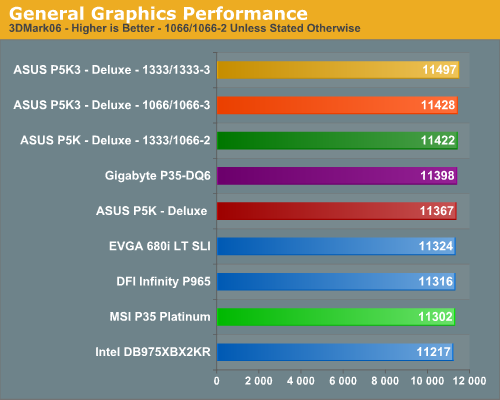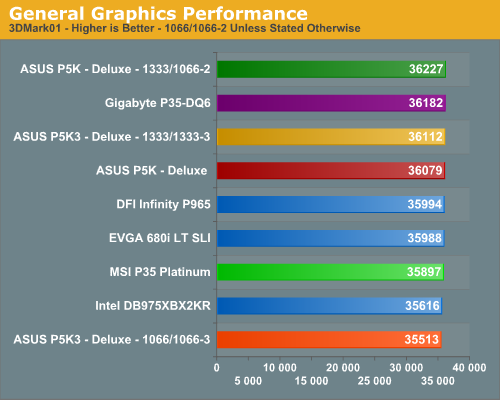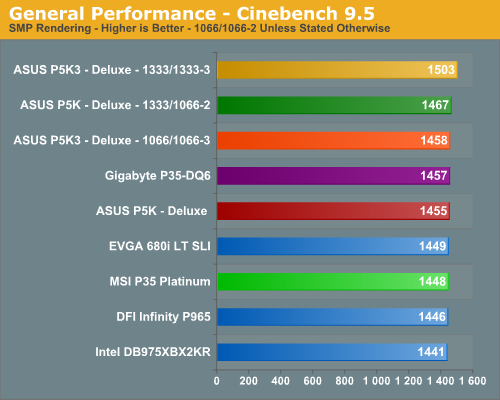Intel P35: Intel's Mainstream Chipset Grows Up
by Gary Key & Wesley Fink on May 21, 2007 3:45 PM EST- Posted in
- CPUs
Synthetic Graphics Performance
The 3DMark series of benchmarks developed and provided by Futuremark are among the most widely used tools for benchmark reporting and comparisons. Although the benchmarks are very useful for providing apples-to-apples comparisons across a broad array of GPU and CPU configurations they are not a substitute for actual application and gaming benchmarks. In this sense we consider the 3DMark benchmarks to be purely synthetic in nature but still very valuable for providing consistent measurements of performance.

In our 3DMark06 test, all of the boards are grouped together with a 2.5% spread from top to bottom. The 975X board takes last place by a small margin, and we noticed in this benchmark that the R600 and 975X do not play well together as the 975X scores within 64 points of the P5K when using a NVIDIA 8800GTX. The latest beta R600 drivers have cured this problem and we will update our scores with the new 8.38 driver set for the roundup. The additional bandwidth available when using the P5K board at 1333/1066 settings resulted in the best CPU and SM2.0 scores in this benchmark.
In the more memory and CPU sensitive 3DMark01 benchmark we see our ASUS P5K Deluxe board taking top honors but only with the FSB set to 1333 (8x333). The Gigabyte P35-DQ6 has the best stock scores at 1066/1066. Our 975x board is slightly handicapped at the 1066/800 settings although this chipset continues to offer excellent memory performance. The higher latencies on the P5K3 board hurt its stock performance although increasing bandwidth to 1333/1333 makes up for it. The spread from top to bottom is again only 2%, however, so minor differences in performance are not really noticeable in either 3DMark.
General System Performance
The PCMark05 benchmark developed and provided by Futuremark was designed for determining overall system performance for the typical home computing user. This tool provides both system and component level benchmarking results utilizing subsets of real world applications or programs. This benchmark is useful for providing comparative results across a broad array of Graphics, CPU, Hard Disk, and Memory configurations along with multithreading results. In this sense we consider the PCMark benchmark to be both synthetic and real world in nature, and it again provides for consistency in our benchmark results.

The ASUS boards have historically done well in this benchmark due to very strong multitasking performance and the same holds true once again. The stock P5K3 scores continue to show an issue with high latencies as this board scored at the bottom in the general application test. The increase to the 1333FSB provides slightly better results with the main increases coming in the multitasking tests. The spread in overall scores is only 1.5%, although in individual areas the differences between the boards may be more or less pronounced.
Rendering Performance
We are using the Cinebench 9.5 benchmark as it tends to heavily stress the CPU subsystem while performing graphics modeling and rendering. Cinebench 9.5 features two different benchmarks with one test utilizing a single core and the second test showcasing the power of multiple cores in rendering the benchmark image. We utilize the standard multiple core benchmark demo and default settings.

The improved bandwidth and front side bus speeds of the P5K3 board results in the top score, putting it 2.5% ahead of the closest competitor for the time being. The remaining boards are all clustered within 2% of each other, with most of the P35 boards placing ahead of the incumbents.










58 Comments
View All Comments
Wesley Fink - Monday, May 21, 2007 - link
Early boards will be expensive, just like always. The prices will likely drop to the same levels as current P965 boards they replace, with a broad range for P35 boards from basic to "Asus Commando" level gaming boards. It is too early to be discouraged.Comdrpopnfresh - Tuesday, May 22, 2007 - link
I'm willing to bet we'll see them replacing the older boards quickly too. If intel and other manufacturers really want DDR3 to go through, you'll see DDR2 boards disappearing quickly. Its like what happened to s939. Basically the same chips were used for AM2, but the boards and chips quickly dried up and disappeared. The same can be said or PCI-e. In the beginning there wasn't much of a real world benefit, just the theoretical bandwidth increase. Because developments in AGP ceased, we might never know if the switch was necessary.Comdrpopnfresh - Monday, May 21, 2007 - link
If something other than NAND flash could be used, it would be very interesting to see a pci-e 1x board that can house DDR2 memory for use in turbo memory. That way, when people upgrade their ~35 boards to DDR3 when performance and price changes, the DDR2 can be used further. This would make a lot of sense too, because unlike Gigabyte's i-RAM device and logical ramdrives, the high speed, low latency properties of RAM could be used for turbo memory as a way around the 8gb limit of RAM on these cards. And since they are not used for storage, merely access, no redundancy on power supply is needed as with the i-RAM. Someone should start development on this...Comdrpopnfresh - Monday, May 21, 2007 - link
Why would the TDP on the P35 higher if it has no integrated video? Will third-party manufactures implement their own SLI into the P35 given that the reference model only had on x16 pci-e slot? Also, when can we expect to see pci-e2 and more than 4 dimm slots on intel mobos?yacoub - Monday, May 21, 2007 - link
Including a jumper to change the strap setting for the fsb is a nice feature on the MSi board. A little disappointed in the memory comparison test that that board had the lowest bandwidth and most latency. Is that something BIOS updates can improve or is that generally hardware (i.e. board design related)?Gary Key - Monday, May 21, 2007 - link
It is all BIOS tuning in regards to the MSI board. Our first results with the board had the memory performance being equal to the 945P boards. Two BIOS releases later and the improvements have been remarkable. I think MSI is about two BIOS spins behind ASUS and Gigabyte now. Gigabyte finally caught up but ASUS still has the better feature set and options in my opinion.michal1980 - Monday, May 21, 2007 - link
hardocp, seems to take a 180 different outlook on these boards. so werid.skaterdude - Monday, May 21, 2007 - link
What's so weird? Kyle is an extension of AMD's marketing department. He has not cared for Intel in a very long time, at least since he was caught cheating on some Intel benchmarks and was hung out to dry for it. Personally, it is alright to have a favorite company to root for but to do so in such an open and bias way is wrong if you are not running a company specific website. I would not have an issue at all if it was called HardAMD, at least you know what you are viewing is not tainted by free trips, booze, products, and general hostility against a company.
Back on subject....The P35 is a nice upgrade and it may not set the world on fire but it appears Intel listened and improved on a chipset they could have let ride for a lot longer. DDR3 will be interesting and at least the kinks will be worked out by the time X38 and the new processors get here. If I had not already bought a 965 board then P35 would have been the one. I am still miffed about not having a native IDE port as JMicron just plain sucks most of the time.
strikeback03 - Tuesday, May 22, 2007 - link
the P35 does not have native IDE either, and why use an IDE drive anyway?Spoelie - Monday, May 21, 2007 - link
ahum, AMD biased? After reading some of their recent gpu reviews, I thought it was the other way around... Check yourselfanyway, not a worthy upgrade, but a worthy new board. Which is what you could reasonably expect.